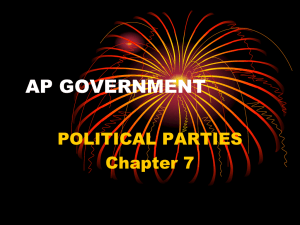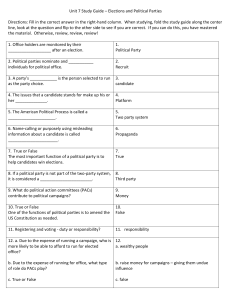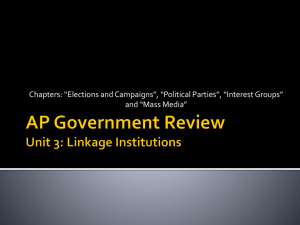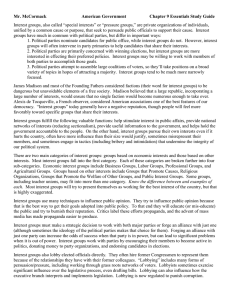Party - Images
advertisement
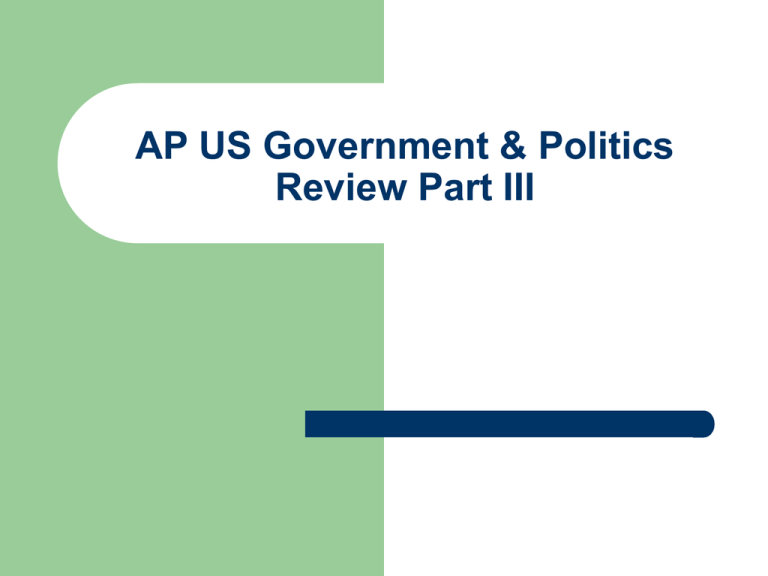
AP US Government & Politics Review Part III Political Parties, interest groups, and mass media: mechanisms that facilitate the communication of interests and preferences by like-minded citizens (10-20%) 1. Political parties and elections (including their functions, organization, historical development, and effects on the political process) 2. Interest groups (including PACs) A. The range of interests that are or are not represented B. The activities of interest groups C. The effects of interest groups on the political process D. The unique characteristics and roles of PACs in the political process 3. The mass media A. The functions and structures of the media B. The impact of media on politics Political parties and elections Where do political parties exist? A. B. C. D. As a label, in voters’ minds As an organization, recruiting and campaigning for candidates As a set of leaders, organizing and trying to control legislative and executive branches US parties have become weaker in all three arenas How U.S. political parties differ from those of other Western nations a. Less control over nominations: primary elections b. Less control over campaigns: candidates get funds independently c. Less control of elected members 3 Major Causes of these differences a. Decentralization of federal system b. Regulation of parties by state and federal laws c. Separation of legislative and executive powers History of Political Parties 1. Founding (1789-1820) •Parties created and constituted loose caucuses of political notables in various localities – with New England strongly Federalist (followers of Hamilton) and much of the South Republican (followers of Jefferson) •Political participation was limited and nominations for most local offices arranged rather casually. 2. Jacksonian (1824-Civil War) •Party convention invented (replaced caucus composed of members of Congress) nominate presidential candidates •Two-party system emerged; •Political participation a mass phenomenon with parties built from bottom up 3. Civil War and Sectionalism – 1930’s • Comprehensive organizational form and appeal developed – both parties tried to straddle slavery issue • Republicans dominated nationally but competition at local level • Both parties split into two factions, stalwarts and progressives 4. The Era of Reform: New Deal – Present • Reforms to reduce political corruption - also weakened parties • Use of primaries to replace nominating conventions • Favored nonpartisan elections at local level • Strict voter registration • Civil Service reform to eliminate patronage National Party Structure Today A. Parties similar on paper 1. 2. 3. 4. National convention has ultimate power; meets every 4 years National committee composed of delegates from states; manages party between conventions Congressional Campaign Committees support party’s congressional candidates National chair manages daily work National Party Structure, continued B. Party structures diverged in 1960s & 1970s 1. RNC became more bureaucratic 2. DNC became more factionalized C. National Conventions 1. Selection of delegates different 2. DNC delegates became more liberal, RNC more conservative 3. DNC rules to include more women and minority delegates 4. Conventions today only ratify primary voters’ selections and never actually choose nominee Types of Party Organizations a. The Machine: use of tangible incentives such as money, political jobs, opportunity to get favors from government, and characterized by a high degree of leadership control over member activity. Examples: Chicago, Philadelphia, Albany b. Ideological parties: Principle above all else, spurns money incentives, today exist as social movements within the political party such as the Christian Coalition. Examples: independent 3rd parties like the Socialist, Libertarian, Right to Life, Prohibition c. Solidary groups: Join for social reasons = fun. Advantages of such groups is they are neither corrupt or inflexible. Disadvantage is they don’t work very hard. d. Sponsored parties: Created or sustained by another organization. Example: Detroit Democrats which has been developed, led, & financed by the political arm of the United Auto Workers e. Personal followings: Devotion to politician and family. Work to get person elected. Example: Kennedys The Political Spectrum Declining Partisan Loyalties Two-Party System A. B. C. Very few other countries have two-party system Evenly balanced nationally, not locally Why has two-party system endured? 1. 2. Winner-take-all and plurality systems State laws make it difficult for minor parties to get on ballot Minor parties and their impact on American politics a. Ideological Parties: Parties professing a comprehensive view of American society and government that is radically different from that of the established parties. Most have been Marxist in outlook, but some are quite the opposite, such as the Libertarian Party. Examples: Socialist Party (19011960’s), Communist Party (1920’s to present), Libertarian Party (1972-Present) b. One-Issue Parties: Parties seeking a single policy, usually revealed by their names, and avoiding other issues. Examples: Free Soil Party (to prevent the spread of slavery (1848-1852); American or “Know Nothing Party” – to oppose immigration and Catholics (1856); Prohibition Party – to ban the sale of liquor (1869-Present); Women’s Party – to obtain the right to vote for women (19131920) c. Economic-protest Parties: Parties, usually based in a particular region, especially involving farmers that protest against depressed economic conditions. These tend to disappear as conditions improve. Examples: Greenback Party (1876-1884), Populist Party (1892 –1908) d. Factional Parties: Parties that are created by a split in a major party, usually over the identity and philosophy of the major party’s presidential candidate. Examples: Split from Republican Party = Bull Moose Progressive Party (1912); La Follette Progressive Party (1924); Split from Democratic Party = States Rights (“Dixiecrat”) Party (1948); Henry Wallace Progressive Party (1948); American Independent (George Wallace) (1968); Split from both Reps and Dems = Reform Party (Ross Perot) The Effect of Third Parties on Vote Distribution Presidential Nominating Process A. B. Parties must appease extreme wings during nominating process, but need a moderate candidate to win an election Delegates not representative of voters— Democratic delegates much more liberal, Republican much more conservative How do Presidential and Congressional races differ? A. Presidential races are more competitive than congressional races (Congress--no term limits and tough to run against an incumbent) B. Fewer people vote in non-Presidential elections = Congressional races must be appealing to the more motivated, partisan voter C. Members can do things for constituents and get credit that Pres. can’t do D. Congressional candidate can deny responsibility for mess in Washington E. Power of presidential coattails has declined Running for President A. B. C. D. E. Getting mentioned Time: Reagan, 6 years; may need to resign from office Money: Individuals $1,000, PACs $5,000 to each candidate in each election Candidates must raise $5,000 in 20 states in individual contributions of $250 or less to qualify for federal matching funds (PAC contributions don’t count) Organization: large staff Running for President, continued F. Strategy and Themes 1. Incumbents defend record; challengers attack 2. Setting a tone (positive/negative) 3. Develop a theme 4. Target voter Primary vs. General Campaigns A. B. C. Different voters, workers, media attention Activists vote in primaries, more ideological Must be conservative or liberal enough to get nominated, then run from the center to get elected The General Election Campaign: each Presidential hopeful must •Target the campaign – strategy to achieve electoral majority •Take advantage of political assets – incumbency •Develop an image the voter responds to •Attract the support of divergent groups •Use issues and events for their own advantage •Take advantage of the media as a primary means of communicating with the public •Use the campaign organization and workers to get the vote out (labor, religious groups, etc.) Parties Aim Their Campaigns to the Middle Two Kinds of Campaign Issues: Position and Valence A Valence Issue is one on which voters distinguish rival parties by the degree to which they associate each party or candidate with conditions, goals, or symbols the electorate universally approves or disapproves of. Examples are economic prosperity and political corruption. Two Kinds of Campaign Issues: Position and Valence A Position Issue is one on which the rival parties or candidates reach out for the support of the electorate by taking different positions on a policy question that divides the electorate. Examples: Slavery or not, high tariffs or low tariffs. Impact of TV, Debates, and Direct Mail on Campaigns A. Spots (paid advertising) can help little-known candidates become known B. Voters get more information from spots than from news broadcasts C. Visuals (news broadcasts) cost candidates nothing D. Debates usually an advantage only to challenger; incumbent or frontrunner runs risk of gaffe E. Direct Mail made easier by computers; mailings can be targeted; result in donations Money A. B. C. D. Presidential primaries partly funded with public money Presidential general elections: all public money unless candidate chooses not to accept Congressional elections: all private money Reform following Watergate scandal 1. Federal Election Campaign Act 1974: limits on individual donations; created PACs, with limit on donations; primary and general elections counted separately for donations Money, continued E. F. G. Supreme Court ruled in Buckley v. Valeo that limits could not be set on individual spending of own money in campaigns unless federal money received “Soft money”—unlimited contributions to party organizations, not candidates, can only be used for “party building” but really used to promote campaigns Soft money banned in 2002; law recently held unconstitutional Money, continued H. Advantages of incumbency 1. 2. 3. 4. Fundraising: PACs contribute to incumbents because they get re-elected Can provide constituent services Can use free mailings Can get free publicity What decides elections? A. B. C. D. Party identification most commonly used factor Issues, especially economy 1. Retrospective voting: based on how things are going and have been going; usually helps incumbent unless economy is bad 2. Prospective voting: based on how things will go—used by few voters Campaigns make a difference 1. Emphasize themes over details 2. Primaries have become more important Winning coalitions 1. Democratic: Blacks, Jews, Hispanics not as much; Catholics, unionists, southerners have been departing coalition 2. Republican: business and professional people; farmers What is meant by a realigning election? The issues that separate the parties change, and so the kind of voters supporting each party change. There have been 5 realignments: a. 1800 – Jeffersonian Republicans defeated the Federalists b. 1828 – Jacksonian Democrats came to power c. 1860 – Whig Party collapsed and Republicans under Lincoln came to power d. 1896 – Republicans defeated Wm. Jennings Bryan e. 1932 – Democrats under FDR came into power Shift of presidential voting patterns in the South The party alignment among white southerners has gone from six-to-one Democratic in 1952 to about 50-50 Democrats and Republicans. If the trend continues, it will constitute a major realignment in a region of the country that is growing rapidly in population and political clout. Interest Groups • Special interest groups including lobbyists and political action committees have been one of the most criticized components of the political process. •Definition of an interest group: A public or private organization, affiliation, or committee that has as its goal the dissemination of its membership’s viewpoint. The formation of Special Interest Groups •Common Interest •Formal organization created •Goals defined by organization •Lobbyists hired and PACs formed •Attempts to influence legislators Why are Interest Groups are so common in the US? a. The more cleavages, along religious, cultural, and regional lines in society, the greater the variety of interests that will exist. b. American constitutional system allows for a federal, decentralized system and therefore multiple points groups can access the government c. Political parties are weak and interest groups can therefore gain strength. Two Kinds of Interest Groups a. Institutional: organizations that represent other organizations. Lawyers/PR firms represent interest of company in Washington – Like GM, Chamber of Commerce b. Membership: Groups supported by activities and contributions of individuals = Sierra Club, NAACP Incentives to join interest groups a. Solidary: Sense of status, pleasure, companionship that arises out of meeting together in small groups. Face-toface contact important, so organize in small local groups = League of Women Voters, PTA, Rotary Club b. Material: Receive money or other valued group or service from membership = AARP supply low cost insurance, discount drugs, travel c. Purposive: Appeal of stated goals to recruit members How interest groups raise funds 3 sources of funds: a. Foundation Grants: Environmental Defense Fund supported almost entirely by grants from foundations like the Rockefeller Family Fund b. Federal Grants and Contracts: Cutbacks in 1980’s hurt interest groups c. Direct Mail: Letters to targeted recipients The activities of interest groups a. Information: most important influence because officials need detailed material; most valuable when issue is narrow or complex b. Public Support: Grassroots lobbying aimed at generating public pressure. Politicians try to avoid controversy. Target legislators with whom agree c. Money and PACs: Money is one of the least effective ways interest groups advance their causes because of regulations and ideological PACs consume almost of all the money raised with massive direct-mail solicitations. d. “Revolving Door”: federal government official takes job in private industry e. Causing trouble: disruptive tactics like protest marches and picketing How the government regulates interest groups a. Federal lobbying law – must register as lobbyists, names of clients, income and expenditure, issues on which they worked -don’t apply to “grassroots” groups b. Tax code and campaign finance laws – if organization does serious lobbying, will lose its tax-exempt status The Media Bad News About Presidential Candidates Increases The 4 periods of journalistic history in the U.S. a. Party Press: Early years of republic --Papers subsidized by political parties; addressed small elite; ruthlessly partisan b. Popular Press: changes in society and technology, like high speed rotary press, made possible rise of a self-supporting, massreadership daily paper; publishers could become powerful political forces, sometimes associated with yellow journalism c. Magazines of opinion: Reaction of middle class to yellow journalism led to less sensationalism and more nonpolitical coverage d. Electronic Journalism: Radio & TV allows for direct politician voter link; get “sound bite”, selective viewing, and need for dramatic to get coverage; Radio 1920s, TV 1940s Influence on politics that the national media can have a. Gatekeeper: Influence what becomes an issue and for how long; example = crime, Vietnam b. Scorekeeper: Make or break politicians reputations; examples = Carter, Gary Hart, George McGovern c. Watchdog: examining political and personal lives; examples = Gary Hart, Bill Clinton, Gary Condit Regulation of the content of television and radio a. Equal time rule: If a station sells time to one candidate, it must be willing to sell equal time for opposing candidate b. Right to reply rule: If a person is attacked on a broadcast other than in a regular news program, that person has the right to reply over the same station. c. Political editorializing rule: If a broadcaster endorses a candidate, the opposing candidate has a right to reply Routine, selected, and insider stories a. Routine: public events regularly covered by reporters, comparatively little of bias b. Selected: Public events knowable to inquiring reporters but not usually reported, bias of reporter/editor may figure prominently in selection c. Insider: Events not usually public, revealed because someone inside reveals them, problem of the motive of the leaker The impact of the media on politics A. B. C. D. E. F. G. Studies of media impact on elections generally inconclusive Local newspapers often endorse Republican candidates National conventions scheduled to accommodate television Candidates win party nomination via media exposure TV influences political agenda Newspaper readers see bigger contrast between candidates than TV viewers TV news affects popularity of presidents Government and the news A. B. C. D. Teddy Roosevelt: systematically cultivated press FDR: press secretary cultivated press; FDR had press conferences Press secretary today: large staff Coverage of Congress never equal to coverage of president; live cameras in House 1978, Senate 1986

